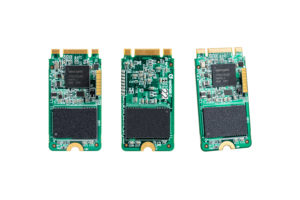Innogrit Debuts With Four NVMe SSD Controllers
A new SSD con┬Łtrol┬Łler desi┬Łgner is coming out of ste┬Łalth mode today. Inno┬Łgrit was foun┬Łded in 2016 by sto┬Łrage indus┬Łtry veterans with the goal of deve┬Łlo┬Łping sto┬Łrage tech┬Łno┬Łlo┬Łgy to sup┬Łport AI and big data appli┬Łca┬Łti┬Łons. We spo┬Łke with co-foun┬Łder Dr. Zining Wu (form┬Łer┬Łly MarvellŌĆÖs CTO) about the companyŌĆÖs plan┬Łned pro┬Łduct lin┬Łe┬Łup, and he will be pre┬Łsen┬Łting more infor┬Łma┬Łti┬Łon next week in a key┬Łnote speech at Flash Memo┬Łry Summit.
InnogritŌĆÖs long term goal is to go after the enter┬Łpri┬Łse sto┬Łrage mar┬Łket, but they are start┬Łing small with a DRAM┬Łless cli┬Łent SSD con┬Łtrol┬Łler, the IG5208 ŌĆ£Shas┬ŁtaŌĆØ. This is alre┬Ła┬Łdy in mass pro┬Łduc┬Łtion with full turn┬Łkey refe┬Łrence SSD designs available. It will be fol┬Łlo┬Łwed up incre┬Łmen┬Łtal┬Łly lar┬Łger con┬Łtrol┬Łlers with more advan┬Łced fea┬Łture sets: Shas┬Łta+, Rai┬Łnier and Taco┬Łma. With each ite┬Łra┬Łti┬Łon, Inno┬Łgrit is incre┬Łasing per┬Łfor┬Łmance, adding more fea┬Łtures and impro┬Łving their LDPC error cor┬Łrec┬Łtion engine.
| Inno┬Łgrit NVMe SSD Con┬Łtrol┬Łler Roadmap | |||||
| Con┬Łtrol┬Łler | Shas┬Łta | Shas┬Łta+ | Rai┬Łnier | Taco┬Łma | |
| Model Num┬Łber | IG5208 | IG5216 | IG5236 | IG5668 | |
| Host Inter┬Łface | PCIe 3 x2 | PCIe 3 x4 | PCIe 4 x4 | PCIe 4 x4 | |
| Pro┬Łto┬Łcol | NVMe 1.3 | NVMe 1.4 | |||
| NAND Chan┬Łnels | 4 | 4 | 8 | 16 | |
| Max Capa┬Łci┬Łty | 2 TB | 2 TB | 16 TB | 32 TB | |
| DRAM Sup┬Łport | No (HMB Supported) | DDR3/4, LPDDR3/4 32/16-bit bus |
DDR3/4, LPDDR3/4, 72-bit bus |
||
| Manu┬Łfac┬Łtu┬Łring Process | 28nm | ŌĆ£16/12nmŌĆØ | |||
| BGA Packa┬Łge Size | 10x9mm, 7x10mm |
7x11mm, 10x10mm |
15x15mm | 17x17mm | |
| Sequen┬Łti┬Łal Read | 1750 MB/s | 3.2 GB/s | 7 GB/s | 7 GB/s | |
| Sequen┬Łti┬Łal Write | 1500 MB/s | 2.5 GB/s | 6.1 GB/s | 6.1 GB/s | |
| 4KB Ran┬Łdom Read | 250k IOPS | 500k IOPS | 1M IOPS | 1.5M IOPS | |
| 4KB Ran┬Łdom Write | 200k IOPS | 350k IOPS | 800k IOPS | 1M IOPS | |
| Mar┬Łket Segment | Cli┬Łent | Cli┬Łent | High-end Cli┬Łent, Datacenter |
Dat┬Ła┬Łcen┬Łter, Enterprise | |
The Shas┬Łta and Shas┬Łta+ con┬Łtrol┬Łlers are both pri┬Łma┬Łri┬Łly tar┬Łge┬Łting the cli┬Łent SSD mar┬Łket, and they are desi┬Łgned as low-cost main┬Łstream solu┬Łti┬Łons. Shas┬Łta has just two PCIe 3 lanes while Shas┬Łta+ has four lanes and con┬Łse┬Łquent┬Łly hig┬Łher per┬Łfor┬Łmance, but other┬Łwi┬Łse they are quite simi┬Łlar. Both are 28nm designs and use the NVMe Host Memo┬Łry Buf┬Łfer fea┬Łture rather than inclu┬Łding DRAM con┬Łtrol┬Łlers. Both con┬Łtrol┬Łlers are small enough to be packa┬Łged insi┬Łde sin┬Łgle-chip BGA SSDs, and InnogritŌĆÖs refe┬Łrence designs for Shas┬Łta-based SSDs include the stan┬Łdard 11.5x13mm and 16x20mm BGA SSD foot┬Łprints and a CFX card design. The impro┬Łved ECC capa┬Łbi┬Łli┬Łties of Shas┬Łta+ will make it a bet┬Łter choice for QLC-based SSDs, but both con┬Łtrol┬Łlers sup┬Łport the full ran┬Łge of SLC through QLC from mul┬Łti┬Łple manufacturers.
Becau┬Łse Shas┬Łta and Shas┬Łta+ are step┬Łping stones toward the enter┬Łpri┬Łse and dat┬Ła┬Łcen┬Łter mar┬Łkets, they include sup┬Łport for some fea┬Łtures not com┬Łmon┬Łly found on cli┬Łent SSDs, such as an Open-Chan┬Łnel SSD ope┬Łra┬Łting mode. End-to-end data path pro┬Łtec┬Łtion is included, with ECC on all the controllerŌĆÖs SRAM buf┬Łfers and on data stored in the Host Memo┬Łry Buf┬Łfer. Power manage┬Łment appro┬Łpria┬Łte for cli┬Łent and embedded use is sup┬Łport┬Łed, with Shas┬Łta pea┬Łking at 0.9W and sup┬Łport┬Łing idle sta┬Łtes at 55mW and less than 1mW, while Shas┬Łta+ will peak at about 1.35W. The NVMe Boot Par┬Łti┬Łti┬Łon fea┬Łture is also sup┬Łport┬Łed for embedded sys┬Łtems that donŌĆÖt include a sepa┬Łra┬Łte boot ROM device.
InnogritŌĆÖs Rai┬Łnier con┬Łtrol┬Łler is a signi┬Łfi┬Łcant gene┬Łra┬Łtio┬Łnal advan┬Łce over the Shas┬Łta fami┬Łly, moving up to the high-end cli┬Łent and ent┬Łry-level dat┬Ła┬Łcen┬Łter mar┬Łkets. Rai┬Łnier swit┬Łches to one of TSMCŌĆÖs 16/12nm Fin┬ŁFET pro┬Łces┬Łses, which Inno┬Łgrit (and most other con┬Łtrol┬Łler desi┬Łgners) sees as neces┬Łsa┬Łry for PCIe gen4 sup┬Łport with reasonable power con┬Łsump┬Łti┬Łon. Rai┬Łnier has 8 NAND chan┬Łnels that can run at up to 1200MT/s, fast enough for any curr┬Łent┬Łly-available NAND. This allows for sequen┬Łti┬Łal read and wri┬Łte speeds of up to 7GB/s and 6.1GB/s respec┬Łtively, more or less satu┬Łra┬Łting the PCIe 4 x4 inter┬Łface. Rai┬Łnier adds enter┬Łpri┬Łse-ori┬Łen┬Łted fea┬Łtures like mul┬Łti┬Łple name┬Łspace sup┬Łport and SR-IOV vir┬Łtua┬Łliza┬Łti┬Łon, but cli┬Łent-ori┬Łen┬Łted power manage┬Łment is still sup┬Łport┬Łed, with idle sta┬Łtes for 50mW and less than 2mW.
The most powerful con┬Łtrol┬Łler on InnogritŌĆÖs road┬Łmap is Taco┬Łma, which builds on Rai┬Łnier by doubling the NAND chan┬Łnel count to 16 (brin┬Łging the maxi┬Łmum sup┬Łport┬Łed capa┬Łci┬Łty up to 32TB), widening the DRAM inter┬Łface to 72 bits (64b with ECC), and adding more high-end enter┬Łpri┬Łse fea┬Łtures. Sequen┬Łti┬Łal IO per┬Łfor┬Łmance will be rough┬Łly the same as for Rai┬Łnier but ran┬Łdom IO gets a boost from the extra par┬Łal┬Łle┬Łlism. The vir┬Łtua┬Łliza┬Łti┬Łon capa┬Łbi┬Łli┬Łties have been enhan┬Łced rela┬Łti┬Łve to Rai┬Łnier and the NVMe Con┬Łtrol┬Łler Memo┬Łry Buf┬Łfer fea┬Łture is sup┬Łport┬Łed, which comes in han┬Łdy for NVMe over Fabrics deploy┬Łments. A spe┬Łcial low-laten┬Łcy mode is intro┬Łdu┬Łced, which Inno┬Łgrit will be demons┬Łt┬Łra┬Łting with ToshibaŌĆÖs XL-FLASH (their ans┬Łwer to SamsungŌĆÖs ZŌĆæNAND). Per┬Łhaps the most important fea┬Łture of Taco┬Łma is the addi┬Łti┬Łon of in-sto┬Łrage com┬Łpu┬Łte with a deep lear┬Łning acce┬Łle┬Łra┬Łtor; more infor┬Łma┬Łti┬Łon about this will be shared next week during InnogritŌĆÖs key┬Łnote pre┬Łsen┬Łta┬Łti┬Łon at Flash Memo┬Łry Summit.
InnogritŌĆÖs busi┬Łness model will be simi┬Łlar to most other inde┬Łpen┬Łdent SSD con┬Łtrol┬Łler ven┬Łdors, offe┬Łring SSD ven┬Łdors a ran┬Łge of opti┬Łons from a basic SDK for cus┬Łtom firm┬Łware up to full turn┬Łkey SSD designs. They have seve┬Łral design wins with the Shas┬Łta fami┬Łly con┬Łtrol┬Łlers and are alre┬Ła┬Łdy sam┬Łpling the Rai┬Łnier and Taco┬Łma controllers.

